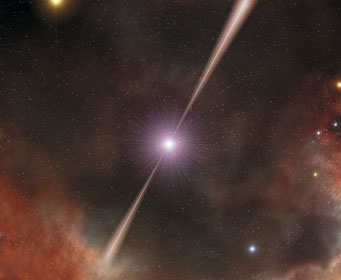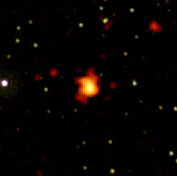Observations from NASA’s Fermi Gamma-ray Space Telescope are hinting that the highest-energy gamma rays travel through empty space at a little less than the speed of light — unlike any other form of electromagnetic radiation. If future observations bear this out, it will rock the foundations of modern physics and perhaps point the way to a "theory of everything" that would help unify the twin pillars of 20th-century physics: Einstein’s general theory of relativity and quantum mechanics.

This artist’s concept depicts what a gamma-ray burst might look like if we could view it up close (this is not something we’d recommend). The explosion triggers two jets, whose particles travel no less than 99.9999 percent the speed of light.
European Southern Observatory
The Fermi satellite, formerly known as the Gamma-ray Large Area Space Telescope (GLAST), launched in June 2008. Its purpose is to the study the extreme universe — exploding stars, cosmic jets, annihilating particles, and other stuff that we wouldn't want happening near Earth. Soon after launch, Fermi started picking up distant gamma-ray bursts (GRBs), powerful explosions usually triggered by dying stars.
On September 16, 2008, Fermi recorded the most intrinsically powerful GRB observed to date. The burst (known as GRB 080916C) took place 12.2 billion years ago, as told by the redshift of its spectral lines. Intriguingly, the highest-energy gamma rays from this GRB arrived a little later than the lower-energy gamma rays. The higher a gamma ray photon’s energy, the shorter its wavelength. These high-energy photons, detected by Fermi’s Large Area Telescope (LAT), have wavelengths one-thousandth the size of an atomic nucleus.

NASA’s Swift satellite picked up the X-ray afterglow of the September 16th gamma-ray burst.
NASA / Swift / Stefan Immler
As predicted by quantum mechanics, and as verified by countless laboratory experiments, space-time becomes turbulent at very tiny scales, as "virtual particles" — electrons and positrons, protons and anti-protons, for instance — pop in and out of existence for fleeting moments: faster than the Heisenberg Uncertainty Principle would allow them to be individually seen. This process should extend all the way down to tiny black holes 10–33 centimeter wide popping in and out of existence in just 10–44 second. In other words, at such a fine scale, space-time itself should become foamy and indeterminate.
But does this happen, really?
According to some theories that attempt to unify quantum mechanics with general relativity, very-short-wavelength gamma rays will begin to "feel" the fine-scale space-time turbulence, which would act to retard their velocity. In other words, if these theories accurately describe nature, high-energy gamma rays would travel slightly slower than the speed of light. You can think of the space-time foam, with all its tiny "hills" and "valleys," as presenting a longer pathway to a small particle than to a larger one that "sees" space as being smooth and flat.
The effect of the space-time foam on something as large (by comparison) as a high-energy gamma photon would be extremely minuscule. It would be nearly impossible to measure in a laboratory experiment. But as Fermi project scientist Steve Ritz (NASA/Goddard Space Flight Center) notes, GRBs give us a chance to conduct the experiment in a laboratory billions of light-years wide. A delay of a few seconds in a 12-billion year journey is a pretty minuscule effect, showing up only in the 16th or 17th decimal place, but it should be easily seen in the arrival times of a fast-acting gamma-ray burst.
The September 16th burst is the most inherently powerful one observed to date, and it was easily seen by Fermi at many wavelengths. With its ability to detect very-high-energy gamma rays and pin down their sky coordinates, Fermi is uniquely suited to carry out this experiment.
The 16.5-second delay for the highest-energy photon observed in this burst is consistent with some of the theories of quantum gravity, which is an exciting development. But before Fermi’s scientists uncork their champagne bottles, they must rule out alternative explanations.
For instance, maybe bursters really do emit their highest-energy photons a few seconds after the rest. Ruling this out will require observing many more GRBs — in particular, to see whether the amount of the delay scales with the distance of the burst, and not with any intrinsic characteristic of the event itself. "Burst emissions at these energies are still poorly understood, and Fermi is giving us the tools to figure them out," says LAT lead scientist Peter Michelson of Stanford University, whose team reports its results in the February 19th Science Express.
Over the next few years, Fermi will detect more and more strong bursts, including at the very shortest wavelengths. If Fermi sees a time lag for high-energy gamma rays that becomes larger with increasing distance in a direct, linear fashion, it would be compelling evidence that these theories of quantum gravity are indeed telling us something profound about nature at its most fundamental scale. If that happens, Fermi scientists may do more than just uncork the champagne; they can start reserving themselves a round-trip ticket to Stockholm.
"This one burst raises all sorts of questions," says Michelson. "In a few years, we'll have a fairly good sample of bursts, and we may have some answers."
On a very different front, scientists have proposed that a strange, irreducible form of noise seen in the GEO600 gravitational-wave detector in Germany is an indirect effect of the same space-time foam.
 15
15
Comments
Mark
February 20, 2009 at 11:48 am
I seem to recall one way to understand this was that the quantum turbulence effectively increases the length that the higher-frequency photons have to travel, making it appear to the observer that the light slowed down. But it didn't really slow down, it just had to wiggle around a bunch to get here.
You must be logged in to post a comment.
rocksnstars
February 20, 2009 at 1:12 pm
Exciting indeed! Since there was nothing mentioned here about String (non)Theory, I'm hoping this proves out and that it puts a nail in the coffin of that silliness.
You must be logged in to post a comment.
Jeff Wise
February 20, 2009 at 2:01 pm
If the origin of the GRB was 12.2 billion lightyears away, wouldn't the burst as we detected it show a significant red-shift due to the distance/time traveled? Wouldn't that also imply that the energy level of the burst was higher than measured by Fermi? What is the upper limit of gamma ray energy -- is it determined by the Planck constant? Thanks for your attention.
Sincerely,
Jeff Wise
Louisville, Ky.
You must be logged in to post a comment.
Nathaniel Sailor
February 20, 2009 at 2:33 pm
Oh yeah, my astronomy teacher is going to love this. Yeap he gona think it's cool. And the gamma rays slowing down, I think that is cool!!
You must be logged in to post a comment.
Nathaniel Sailor
February 20, 2009 at 2:33 pm
Oh yeah, my astronomy teacher is going to love this. Yeap he gona think it's cool. And the gamma rays slowing down, I think that is cool!!
You must be logged in to post a comment.
Don Cross
February 20, 2009 at 8:47 pm
It is interesting that sounds waves do something similar, only in reverse. If you are really close to a lightning strike, it sounds like an instantaneous explosion. But if you are very far away, you hear the high-pitched crack first, then the low-frequency rumble and boom later. I have read about the Loop Quantum Gravity theory that says both time and space are quantized, so it may be related to how sound waves are really just microscopic collisions between molecules.
You must be logged in to post a comment.
John Ståhle
February 21, 2009 at 4:41 am
The same was observed in connection with at gamma ray burst from Markarian 501 in 2007.
You must be logged in to post a comment.
Howard
February 21, 2009 at 9:29 am
A simpler classical explanation is that the higher energy gamma rays are being preferentially scattered (Compton/Inverse Compton scattering) by the highly ionized intergalactic/interstellar media on their journey to Earth.Through downconversion/upconversion scattering the highest energy gamma rays will be delayed relative to the lower energy spectral components.
You must be logged in to post a comment.
Mitch
February 21, 2009 at 12:34 pm
I;m wondering whether or not Peter Michelson, of Stanford is related to the famous Michelson of the Michelson-Morley experiment .
You must be logged in to post a comment.
Peter Wilson
February 21, 2009 at 4:30 pm
A 16.5-second delay over 12.2 billion years? "The most straightforward interpretation of the time delay is that the mechanism that produced the burst created the highest-energy gamma rays a few seconds later than their lower-energy counterparts." That would only make sense.
You must be logged in to post a comment.
Peter Wilson
February 21, 2009 at 4:30 pm
A 16.5-second delay over 12.2 billion years? "The most straightforward interpretation of the time delay is that the mechanism that produced the burst created the highest-energy gamma rays a few seconds later than their lower-energy counterparts." That would only make sense.
You must be logged in to post a comment.
Eric F. Diaz
February 23, 2009 at 12:18 am
I find the possibility that very-short-wavelength gamma rays might be affected by space-time turbulence on the quantum level very intriguing. It should be very interesting to see in the next few years whether or not the data collected by Fermi confirms the theories of quantum gravity.
You must be logged in to post a comment.
Neil Seymour
February 23, 2009 at 6:04 am
Is this just plain old-fashioned dispersion? The shorter wavelengths (higher energy) are slowed down more than the longer wavelengths. This is why a prism displays rainbow colours rather than just a refracted beam of white light. The blue (shorter wavelength) is slowed more than the red wavelength and so is refracted through a larger angle. Even though space is a very close approximation to a vacuum, these gamma rays have crossed about 90% of the "radius" of the universe. Are there enough hydrogen and helium atoms along that enormously long path to have caused this effect?
You must be logged in to post a comment.
Charles
February 24, 2009 at 11:05 pm
By exploring the sequencing of Gamma-ray bursts I have developed a mathematical proof that Gamma-ray bursts are not random.
You must be logged in to post a comment.
Phil
March 1, 2009 at 9:07 am
"I;m wondering whether or not Peter Michelson, of Stanford is related to the famous Michelson of the Michelson-Morley experiment."
I think possibly so. I vaguely recall an article in Sky & Tel within the last couple of years, where the author "X" said he was in fact a descendant of "X" in some famous "X-Y" experiment. That "X" may in fact be Michelson. Anyone else have the reference at hand, or can look up S+T articles by Peter Michelson of Stanford over the last 3 or 4 years?
You must be logged in to post a comment.
You must be logged in to post a comment.